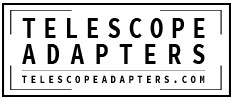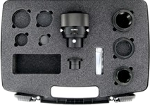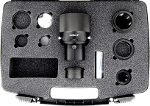No products
Telescope Camera Adapter FAQ
Different Types of Imaging & Camera Mounting
PiggyBack – This method simply uses the telescope as a tracking platform. The camera is mounted to the top of the telescope tube using a “Piggyback Camera Mount” and shoots through it’s own standard camera lens. This method does not offer any gain in magnification or light grasp over what your camera lens provides, it simply allows the camera to follow the sky so long exposures do not streak as the earth moves.
See:
We do not currently carry any Piggyback mounts, consult your telescope manufacturer for an appropriate mount as they are typically made to fit a particular scope model.
Prime Focus – This is the purest form in that it uses the telescope as the camera lens. The camera is not fitted with a lens and the telescope is not fitted with an eyepiece. The camera film plane (or CCD) is placed at the “prime” focal point of the telescope. This method offers the widest, brightest fields, moderate magnification and shortest exposure times. Typically used for imaging nebulae, galaxies and other large deep sky objects. To use this method your camera must have a removable lens (SLR/DSLR/CCD Imagers/Some Webcams). This rules out most all point & shoot type consumer cameras (for these see “Afocal” below).
See:
1.25” Prime Focus Kits (for scopes that accept only 1.25” eyepieces)
2” TRUE-2 UltraWide Adapters (for scopes that can accept 2” eyepieces)
C Mount Adapters (for box type cameras)
Webcam Adapters (for many popular webcams)
Barlow Projection – This method is essentially the same as “Prime Focus” above except that it places a telenegative lens (barlow) between the telescope and camera. This increases the focal length of the system which increases magnification.
See:
1.25” Prime Focus Kits (for scopes that accept only 1.25” eyepieces)
2” TRUE-2 UltraWide Adapters (for scopes that can accept 2” eyepieces)
C Mount Adapters (for box type cameras)
Webcam Adapters (for many popular webcams)
Eyepiece Projection & Variable Projection – This method also requires a camera with a removable lens so it is typically limited to SLRs/DSLRs/CCD Imagers. The camera body is fitted to an eyepiece which is placed in the optical train between the camera and telescope. The eyepiece “projects” the image onto the film plane (or CCD). This provides a method of increasing the magnification just as it does visually. Shorter focal length eyepieces provide higher magnification. Often rather simple eyepiece designs work best for this purpose. A “Variable” projection adapter allows you to adjust the distance between the film plane (or CCD) and the eyepiece. This varies the magnification of the system allowing you more flexibility in adjusting the image size when framing your shots. Typically used for Lunar & Planetary imaging where higher magnification is needed to bring out detail.
See:
Eyepiece Projection Kits
Variable Projection Kits
VariMax (Large) Projection Adapter
AdaptaView Adapter (fits many TeleVue eyepieces)
Afocal – This method is primarily employed with consumer “point & shoot” type cameras. Since these cameras do not have a removable lens they MUST shoot through an eyepiece to form an image. If you were to try to shoot through a scope without an eyepiece you would simply get a picture of the inside of the scope. Care should be used in eyepiece selection for this method since trying to shoot through an eyepiece with a small lens and/or short eye relief will result in a lot of vignetting. Vignetting is when the image has dark corners or a dark circle surrounding it. Minor vignetting such as dark corners can almost be expected with many cameras and can be easily cropped out. But excessive vignetting can be like viewing through a soda straw. Afocal imaging is a compromise, you should expect at least some vignetting. Having said that.. we are after all working with a round image. Fitting it to a rectangular frame forces you to crop off actual imagery. So if you think about it there is always some form of vignetting, it is just either positive or negative. The important thing is to use an eyepiece that can at least fill the rectangular frame with a round image (round image touching top and bottom of frame). That's the real life view, which has captured all of the information in the telescopes entire field of view. For rectangular format images you can just load it into the pc, zoom in and crop any dead area away, while at the same time centering and framing the subject.
The best eyepieces for this purpose will have ALL of the following characteristics:
-Low Power (The lower the better, the camera zoom will provide plenty of magnification)
-Large Eye Lens (preferably nearly as large as your camera lens)
-Long Eye Relief (short eye relief will result in major vignetting)
-A non-recessed lens (if the eye lens is mounted deep in the barrel it is the same as short eye relief)
-A method of attaching it to the camera (it is compatible with our Digi-Kits, AdaptaView or Universal adapters)
Tips for Afocal Imaging:
-Make sure the camera lens and eyepiece lens are spaced very closely together.
-Use an appropriate eyepiece as outlined above.
-Generally most cameras will need to operate at or near maximum zoom to reduce vignetting to a minimum. On a camera with a large zoom range (such as 10X) this may cause the system to be “overpowered” unless you use a very low power eyepiece.
-Some cameras may work best in Macro mode, experiment with yours to see which mode works best.
-If you’re shooting a large bright object such as the Moon your camera may adjust its exposure and focus correctly so long as the telescope is near focus. But the best results will be achieved by going to full manual mode and adjusting the exposure time yourself. Focus using the telescopes focus knob.
- If you don’t have a remote for your camera use the built in self timer feature so you don’t have to touch the setup (causing it to shake) when taking the photo.
See:
Digi-Kits (afocal kits for hundreds of point & shoot cameras)
AdaptaView Adapter (fits many TeleVue eyepieces)
Attachment Kits (used to connect T-Threaded Eyepieces or our AdaptaView to your camera)
Universal Camera Mount (for point & shoot cameras for which there is no Digi-Kit)
Focusing Methods
Regardless of the type of telescope (or camera) focusing is typically done with the telescope focuser knob, not with the camera. Achieving sharp focus can sometimes be a challenge through a tiny viewscreen. There are a number of methods to aid in achieving sharp focus. If your camera is digital you can simply take a picture, then blow it up and see how good the focus is. Some even allow you to zoom in on a live image before you take the shot. However such hit and miss methods can get frustrating when imaging different objects. There are focus masks that can be placed over the front of the scope to aid in focusing but I find these often provide a rather dark image that makes it difficult to judge focus as well. I prefer the “Parfocalizing Ring” method. This method allows you to turn a spare eyepiece into a focusing aid by making it parfocal with your camera (the focus point of the eyepiece matches the camera). Once your camera and parfocal eyepiece have their focus points perfectly matched focusing becomes much easier. Simply focus using the parfocal eyepiece then replace the eyepiece with your camera setup. If you have an ETX or other scope with a built in flip mirror it’s even easier.. simply focus in the eyepiece, turn the flip mirror knob and take a picture. By selecting an eyepiece that has approximately the same field of view as your camera it will aid you in framing the shot as well as focusing. Sometimes a small shake of the camera during the exposure will appear to be an out of focus condition. To reduce shaking use a remote shutter release. If you don’t have a remote simply use the built in timer feature of the camera for “hands off” shake free shots. Some SLR type cameras also have a “mirror lock”, locking the mirror in the up position before taking the shot will also help reduce vibration.
Focusing Issues
Certain types of telescopes tend to have particular issues reaching focus when fitted with a camera. The Afocal method rarely has a problem since the eyepiece is placed at its normal place in the optical train. However the Eyepiece Projection method and especially the Prime Focus method may require physical or optical extensions to place the camera at the proper focal point of the telescope.
Possible focusing issues by telescope type:
Refractors- Since a refractors focus range is limited by the length of its drawtube travel an extension tube is often needed. Many short focus refractors in particular will have too long of an optical path when fitted with a diagonal and too short of an optical path when the diagonal is removed to reach its prime focal point. Typically the diagonal would be removed and an appropriate length extension tube will be put in its place. If your telescope manual does not specify the length of the extension tube required you can figure this out yourself by hand holding the camera behind the drawtube to judge its proper length. When doing this be sure the scope is aimed at an extremely distant object to insure it will reach focus at infinity. Ideally you want the focuser to have just a bit of focus range left beyond infinity and a lot left on the near side so you have the widest possible useable focus range for both near and distant objects. See our Extensions.
Reflector/Newtonian/Dobsonian- Since a reflectors focus range is limited by its focuser drawtube travel there are sometimes focus issues.. typically the focuser reaches the inside end of its travel but it needs to go in just a bit more to reach focus.
There are a number of things you can do if you experience this:
-The most common and easiest solution is to try placing a barlow lens between the telescope and camera. A barlow extends the focal length of the telescope and consequently it moves the focal point rearward a bit, usually just enough for everything to work perfectly. See our Barlows. Important: For this purpose do not confuse a Barlow Lens with a Telecentric Amplifier (TV PowerMate, Explore Scientific Focal Extenders and others). A true Barlow will extend the focal length of the telescope (giving you extra focus room), whereas a Telecentric Amplifier actually uses up some of your focus room.
-Use a low profile camera adapter. Make sure your camera adapter uses as little of the optical path as possible. Most of our TRUE-2 adapters use only 12mm or less of your precious back focus.
-Use a low profile focuser. If your scope has a tall inexpensive rack and pinion focuser consider replacing it with a more modern low profile crayford type focuser. These may provide enough back focus as they are lower than most rack and pinion type focusers.
-Move your primary mirror. Some scopes have 2 sets of holes in the tube for the primary mirror mounting screws. The lower position is for visual use and the upper position is for photography, moving the primary forward moves the prime focus point further out. If you really only need a fraction of an inch you may be able to use the collimation screws to raise the mirror up a bit. If building your own scope you should consider designing it so it needs a short extension tube for visual use, and removing the extension places it in imaging mode. If the scope is a truss type you could also make a second set of shorter trusses for use during imaging.
Schmidt-Cassegrain (SCT)- Generally these scopes focus by moving the primary mirror, this provides a very large range of focus and reaching focus is rarely a problem. Though some Celestron SCTs (mainly the older orange tube C8) have been known to be short on back-focus when also attempting to use a focal reducer in the optical train.
Maksutov (Maks & other mirror lens types)- Most maksutov OTAs focus by moving the primary and do not have issues reaching focus with a camera. If yours has an external focuser and a fixed primary you may need an extension tube or Barlow lens to reach focus.





